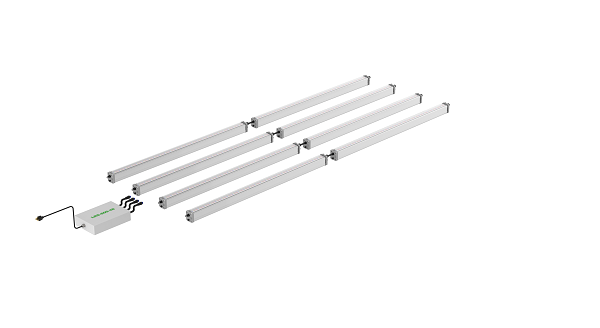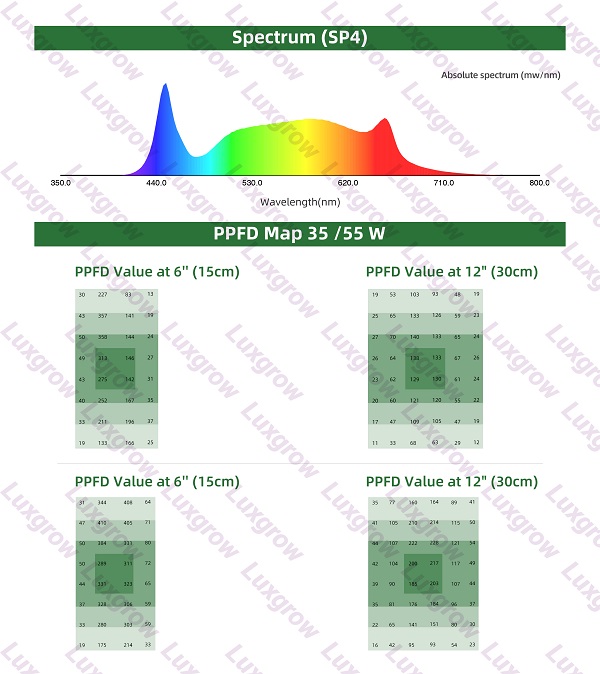In the world of indoor gardening, LED grow lights have revolutionized the way we nurture our plants. These innovative
lighting solutions provide the perfect spectrum of light for photosynthesis, promoting healthy growth and maximizing yields. In this article, we will delve into the benefits of LED grow lights and how they can help you achieve optimal results in your indoor garden.
LED grow lights are designed to mimic the natural light spectrum that plants need for photosynthesis. Unlike traditional lighting sources such as incandescent or fluorescent bulbs, house plant light emit specific wavelengths of light that are readily absorbed by plants. This targeted approach not only ensures that plants receive the light they need to thrive but also minimizes energy wastage.
Energy Efficiency: The best led grow lights 2024 are highly energy-efficient, consuming significantly less power than traditional lighting sources. This not only helps reduce electricity costs but also makes them a more sustainable choice for indoor gardening.
Customizable Spectrum: One of the key advantages of LED grow lights is their ability to provide a customizable light spectrum. By adjusting the intensity and color of the light, growers can tailor the lighting conditions to suit the specific needs of their plants at different growth stages.
Longevity: LED grow lights have a much longer lifespan compared to traditional bulbs, lasting up to 50,000 hours or more. This durability not only reduces the frequency of bulb replacements but also ensures consistent light quality over an extended period.
Low Heat Emission: Unlike traditional lighting sources that emit a significant amount of heat, led grow lamp produce very little heat. This is beneficial for indoor gardens as it helps maintain optimal temperature levels without risking heat stress on plants.
When selecting an LED grow light for your indoor garden, there are several factors to consider:
Light Spectrum: Look for lights that offer a full spectrum of light, including blue, red, and white wavelengths to support all stages of plant growth.
Wattage and Coverage: Consider the wattage of the light and the coverage area it can effectively illuminate to ensure all your plants receive adequate light.
Brand Reputation: Opt for reputable brands known for producing high-quality LED grow lights with proven results.
To maximize plant growth with LED grow lights, it is essential to create an optimal lighting schedule based on the specific needs of your plants. Consider factors such as light intensity, duration, and spectrum to ensure that your plants receive the right amount of light at the right time.

In conclusion, LED grow lights offer a host of benefits for indoor gardeners looking to optimize plant growth and maximize yields. By understanding the science behind LED lighting, choosing the right light for your needs, and implementing a tailored lighting schedule, you can create an ideal environment for your plants to thrive. Embrace the power of LED grow lights and watch your indoor garden flourish like never before.
Enhance the growth and health of your plants with our high-quality fluorescent grow lights. These lights are specifically designed to provide the optimal spectrum of light for photosynthesis, promoting lush foliage, vibrant blooms, and bountiful harvests. Whether you're a seasoned gardener or just starting out, these lights will help you achieve the garden of your dreams.
Our fluorescent grow lights are not only energy-efficient but also cost-effective. By consuming less electricity compared to traditional lighting options, you can save money on your energy bills while still providing your plants with the light they need to thrive. Say goodbye to high energy costs and hello to a greener, more budget-friendly solution for your indoor garden.
Say goodbye to complicated setups and hello to easy installation with our fluorescent grow lights. These lights are designed to be user-friendly, allowing you to set them up quickly and effortlessly. Plus, their versatile design means they can be used for a wide range of plants, from herbs and vegetables to flowers and succulents. Transform any space into a flourishing garden with our fluorescent grow lights.
Maybe you want to know information about these keywords
Efficient Plant Growth
Budget-Friendly Lighting Solution
Simple Installation Process
Versatile Plant Compatibility
Lush Foliage and Vibrant Blooms
Fluorescent grow lights
Plant growth lights
Indoor gardening lights
Energy-efficient plant lights
Easy installation grow lights
"5 Reasons to Choose Our Fluorescent Grow Lights for Your Garden | Shop Now"
"Discover the benefits of our energy-efficient fluorescent grow lights for indoor gardening. Boost plant growth and save on costs with our versatile and easy-to-install lighting solution. Shop now for lush foliage and vibrant blooms.
Light serves as the primary source of energy for plants, driving the process of photosynthesis essential for their growth. When it comes to cannabis, the right balance of light intensity is crucial for optimal development. Insufficient light can lead to stunted growth and poor yields, while excessive light can cause stress and damage to the plant.
Light intensity directly impacts the rate of photosynthesis in cannabis plants. Higher light levels result in increased photosynthetic activity, leading to enhanced growth and development. Adequate light intensity ensures that plants can produce the energy needed to thrive.
Proper light intensity is also linked to nutrient absorption in cannabis plants. When plants receive sufficient light, they can efficiently take up essential nutrients from the soil, promoting healthy growth. Inadequate light intensity can hinder nutrient uptake, leading to nutrient deficiencies and growth issues.
The flowering stage of cannabis plants is particularly sensitive to light intensity. The right amount of light during this phase is crucial for the formation of dense, resinous buds. Insufficient light can result in poor bud development and reduced yields, while optimal light intensity can maximize flower production.
Achieving the ideal light intensity for cannabis cultivation involves striking a balance between intensity, duration, and spectrum. Using high-quality grow lights, such as LED or HPS lamps, can help provide the necessary light levels for robust plant growth. Additionally, adjusting the light cycle based on the plant's growth stage is essential for maximizing yield potential.

The quality of cannabis fruiting depends on the duration of light exposure. The growth cycle of cannabis is called the photoperiod, which plays a key role in regulating the growth phase of the cannabis plant. By controlling the length of the light and dark periods, growers can control the timing of light exposure to affect the basic processes of cannabis vegetative growth, the onset of flowering and bud development.
Adjusting the light schedule is a primary method for managing light duration. During the vegetative stage, cannabis plants typically thrive with 18-24 hours of light per day to support vigorous growth. Transitioning to the flowering stage involves reducing the light cycle to 12 hours of light and 12 hours of darkness to stimulate flower production.
Growers can utilize light-blocking techniques to ensure a consistent light schedule. Implementing light-proof tarps or blackout curtains in the grow space helps block out light during the dark period, providing plants with uninterrupted darkness necessary for proper growth.
Automated light timers are valuable tools for maintaining a consistent light cycle without manual intervention. By programming timers to switch grow lights on and off at specific times, growers can guarantee plants receive the correct duration of light exposure throughout the growth cycle, fostering healthy and robust growth.

Efficiently managing light duration offers numerous benefits for cannabis growers, including:
Optimized Growth: Providing the right balance of light and dark periods enhances vegetative growth and promotes healthy development.
Flowering Control: Controlling the light cycle allows growers to trigger the flowering stage at the desired time, leading to improved bud production.
Energy Efficiency: Regulating light duration optimizes energy consumption, reducing operational costs associated with lighting.
LUXGROW is equipped with cannabis growing lamps: fluorescent lamps, high-pressure sodium lamps, LED lamps
In order to allow cannabis to photosynthesize smoothly, we need to control the light intensity between 35,000 lux and 85,000 lux. Each plant growth lamp will indicate its own light output, but this amount refers to the light output distance at full load and zero distance.
The distance between grow lights and cannabis plants significantly impacts the intensity and distribution of light received by the plants. Proper lighting distance is essential for preventing light burn, promoting photosynthesis, and encouraging healthy growth throughout the plant's life cycle.
Refer to the manufacturer's guidelines for specific recommendations on lighting distance for your grow lights. Different types of grow lights, such as LED, HPS, or fluorescent lights, may have varying optimal distances based on their intensity and spectrum. Adhering to these guidelines can help ensure optimal light exposure for your plants.
Monitor the intensity of light reaching your plants and adjust the lighting distance accordingly. During the vegetative stage, plants may benefit from closer light placement to encourage robust growth. In contrast, increasing the distance during the flowering stage can prevent light burn and promote bud development.
Regularly inspect your plants for signs of light stress, such as leaf discoloration or wilting. Adjust the lighting distance if you observe any negative effects on plant health. Maintaining an appropriate distance between grow lights and plants is crucial for preventing light-related issues and ensuring optimal growth conditions.
Efficiently controlling the lighting distance of marijuana grow lights offers several advantages for growers, including:
Preventing Light Burn: Maintaining the correct distance helps prevent light burn and damage to plant tissues.
Enhancing Photosynthesis: Optimizing lighting distance ensures plants receive adequate light for efficient photosynthesis and nutrient absorption.
Maximizing Yield: Proper light placement throughout the growth cycle can lead to increased flower production and higher yields.

Assess Your Growing Needs: Determine the specific requirements of your cannabis plants, including light spectrum, intensity, and coverage area.
Research Grow Light Options: Explore different types of grow lights available in the market, such as LED, HPS, or CMH (Ceramic Metal Halide), and compare their features and benefits.
Consider Energy Efficiency: Prioritize energy-efficient grow lights to reduce electricity consumption and operating costs over the long term.
Evaluate Budget Constraints: Balance the upfront cost of the grow light setup with its long-term benefits and efficiency to make an informed investment decision.
Seek Expert Advice: Consult with experienced growers or horticultural experts to gain insights and recommendations on selecting the most suitable grow light setup for your cannabis cultivation needs.
Choosing the right cannabis full spectrum grow lights led setup involves considering various factors such as light spectrum, intensity, energy efficiency, coverage area, and heat management. By carefully assessing your growing requirements and researching available options, you can select a grow light setup that optimally supports the growth and yield of your cannabis plants.
Luxgrow is developed by photology engineers and more than 13 years R & D engineers team in led lights
As a professional and rich experience grow light designer and manufacturer for indoor greenhouse farms ; Luxgrow really knows offer the exclusive customized layout service is very necessary and cost-efficient.
We offer free exclusive customized layout service for customers , not only in the lighting configuration help,but also help you know the budget